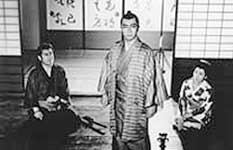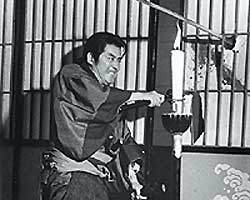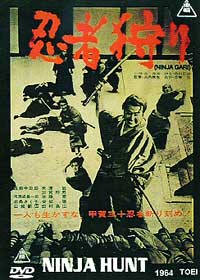Ninja-gari (The Ninja Hunters, Toei, 1964) was the first film directed by Tetsuya Yamanouchi (or Yamauchi), from a story by Koji Takada. It stars veteran chambara star Jushiro Konoe, with Shingo Yamashiro, Kei Sato, Takahiro Tamurai, Choichiro Kawarazaki, & Kikudo Hojo.
 Wada (Jushiro Konoe) was a vassal of the Izamu clan before ninja spies, led by "Kura the Darkness," helped the shogunate topple Izamu clan & turn all Izamu samurai into ronin. Approached by a vassal of the Matsuyama clan, Wada agrees to work with a special anti-ninja unit to track down Kura for the sake of revenge. Wada (Jushiro Konoe) was a vassal of the Izamu clan before ninja spies, led by "Kura the Darkness," helped the shogunate topple Izamu clan & turn all Izamu samurai into ronin. Approached by a vassal of the Matsuyama clan, Wada agrees to work with a special anti-ninja unit to track down Kura for the sake of revenge.
Wada heads the group of four who strive to keep the castle from being infiltrated by ninja, or to find those who already infiltrated & falsely appear to be loyal vassals. The film portrays the excellence of ninja infiltration techniques by means of disguises as nuns, priests, or retainers, as well as by direct assault. Wada is merciless in dealing with them, even sacrificing innocent Matsuyama retainers if that it what it takes to ferret out spies.
As heros go, Wada is a cruel one, exemplified by a sequence wherein Wada tortures then slays, one by one, a group of retainers, knowing only one of them is a ninja. The second-to-last victim of Wada's harsh approach turns out to be the spy, proving it by ninjutsu leaping tactics. The final vassal, although spared the fate of the other innocents, goes mad from the experience.
 The plot hinges on a letter written by the Shogun which recognizes the young Matsuyama heir. An official has planned a meeting to authenticate the letter & thereafter to guarantee protection of the heir as a daimyo (lord) under Tokugawa authority. The shogunate secretly wants the letter destroyed before the meeting can take place, the Shogun having written it only to give the impression of supporting the clan while actually wanting an off-shoot of his own family to take over the Matsuyama domain. The plot hinges on a letter written by the Shogun which recognizes the young Matsuyama heir. An official has planned a meeting to authenticate the letter & thereafter to guarantee protection of the heir as a daimyo (lord) under Tokugawa authority. The shogunate secretly wants the letter destroyed before the meeting can take place, the Shogun having written it only to give the impression of supporting the clan while actually wanting an off-shoot of his own family to take over the Matsuyama domain.
If the letter can be destroyed before the young heir is officially recognized, the clan will be ruined. Historically speaking, these sorts of machinations did take place & provide themes for many films. In The Ninja Hunters it provides a grand excuse for several duels between the special anti-ninja brigade & the spies sent by the shogunate.
Kura, the ninja leader, is a pin-spitter, famous for blinding his opponents. Of the four ninja-hunters (Wada, Hachi, Shin & Yajiro) the youngest, Yajiro, is blinded early on, & commits seppuku as a result. The art of pin-spitting is also used by Shintaro Katsu in his role as a thief in The Thieves' Who's Who (Dosobo banzuke, Daiei, 1966) & by a female spy in a version of the three-part Daibosatsu toge starring Raizo Ichikawa, who is blind in parts II & III but no less invincible. Pin-spitting-jutsu probably isn't a credible martial art, but it is very traditional in fiction.
Giving up on destroying the letter, the ninjas decimated, Kura settles on a new plan to kill the child heir, for not until the letter is read to the proper officials will the child be exempt from a government-ordered assassination. the second attempt on the child's life provides the climax of the film & takes place in a dark, sealed, & eerie tomb. This is just the right environment for mystic, sinister ninjutsu masters like Kura.
SPOILER ALERT. There are only two hunters remaining of the initial four, Shin having been killed by a kunoichi or female ninja (Kukuo Hojo) disguised as a nun, in a totally silly & unrealistic seduction scene complete with Western kiss alien to the period (it's the only truly ineffective scene in the film). So in the climax it is Wada & Hachi against Kura inside the huge dark tomb. Hachi, played by Kei Sata, is quickly blinded by pin spitting & a tense duel-in-darkness proceeds with shurikens, swords, & pins pitting Kura against Wada.
This unusual duel is extremely well staged & choreographed, Wada becoming so severely wounded that he can barely crawl before it is done. The relatively unscathed Kura boasts wickedly as he approaches the hapless child. In a scene reminiscent of a very effective "Boo!" in Wait Until Dark (1967) when the villain presumed dead leaps up to grab the blind Audrey Hepburn, our secondary hero Hachi leaps out of the darkness & clings wildly to Kura until Wada crawls horridly nearer & nearer, ultimately thrusting his sword through his friend's body in order to get at Kura underneath. END SPOILER ALERT
It can be said of this film that Konoe's acting is fine, the cinematography appropriately brooding in black & white as works best in ninja films, & the story is both adequate & easily followed by western viewers. It's a good example of the genuinely entertaining Toei Studios "product" of the early 1960s. It steps a little outside the norm for its decade of "commercial" chambara in that there is very little moral distinction between our point of view heros & their ninja enemies. Both sides are merely pursuing missions assigned to them by rival government factions, conveying more the deadly oppression of the era rather than a dichotomy of good vs bad.
copyright © by Paghat the Ratgirl
|

 Wada (Jushiro Konoe) was a vassal of the Izamu clan before ninja spies, led by "Kura the Darkness," helped the shogunate topple Izamu clan & turn all Izamu samurai into ronin. Approached by a vassal of the Matsuyama clan, Wada agrees to work with a special anti-ninja unit to track down Kura for the sake of revenge.
Wada (Jushiro Konoe) was a vassal of the Izamu clan before ninja spies, led by "Kura the Darkness," helped the shogunate topple Izamu clan & turn all Izamu samurai into ronin. Approached by a vassal of the Matsuyama clan, Wada agrees to work with a special anti-ninja unit to track down Kura for the sake of revenge. The plot hinges on a letter written by the Shogun which recognizes the young Matsuyama heir. An official has planned a meeting to authenticate the letter & thereafter to guarantee protection of the heir as a daimyo (lord) under Tokugawa authority. The shogunate secretly wants the letter destroyed before the meeting can take place, the Shogun having written it only to give the impression of supporting the clan while actually wanting an off-shoot of his own family to take over the Matsuyama domain.
The plot hinges on a letter written by the Shogun which recognizes the young Matsuyama heir. An official has planned a meeting to authenticate the letter & thereafter to guarantee protection of the heir as a daimyo (lord) under Tokugawa authority. The shogunate secretly wants the letter destroyed before the meeting can take place, the Shogun having written it only to give the impression of supporting the clan while actually wanting an off-shoot of his own family to take over the Matsuyama domain.